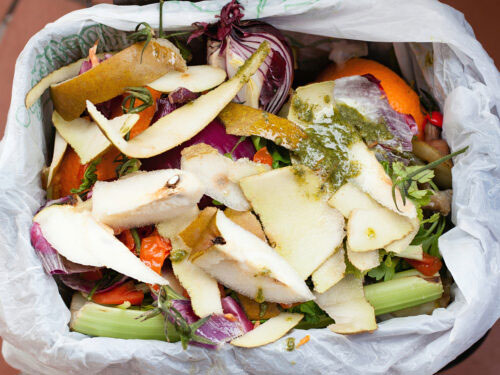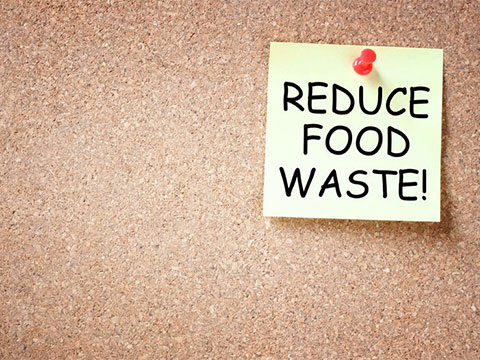4 Ways to Reduce Office Food Waste
- By Jonanna Widner
- Reading Time: 4 mins.
Narrator: She didn’t eat it later.
How many times have you opened up your refrigerator at work to face a wall of half-full Tupperwarecontainers and week-old to-go boxes of food that will eventually be thrown out? Despite our best intentions, we waste a lot of food at work.
 Food waste does more than just stink up your fridge. Reducing food waste is another way your office can lessen its carbon footprint and environmental impact.
Food waste does more than just stink up your fridge. Reducing food waste is another way your office can lessen its carbon footprint and environmental impact.
According to the Save the Food campaign launched by the Ad Council and the Natural Resources Defense Council in April 2016, food is the number one thing that ends up in landfills. In fact, 40 percent of the food in the U.S. goes uneaten. That translates to $218 billion lost, when you take into consideration the “cost of food wasted on the consumer level, retail, wasted water, energy, fertilizers, cropland, and production costs,” the study says.
Even worse, when food in landfills decomposes, it releases methane gas, which is an even more potent greenhouse gas than carbon dioxide.
All the more reason to reduce food waste in your office. Considering the entrenched habits of most workplaces, it may seem like a daunting task, but making a few modifications can help change your office culture. Here are three steps to get you started:
Raise Awareness
Step one toward reducing food waste is being aware. According to the Rockefeller Foundation’s Food Waste Toolkit for the Office, “Most food waste occurs before it even hits our plate. It happens at lunchtime when you throw out the homemade salad that is less appealing once your team orders pizza.”
Make conscious decisions. It’s OK to choose the pizza but commit to eating the salad for dinner. Side benefits include saving money by not eating out so much and possibly making healthier choices.
Hold an office-wide Food Waste Week. It’s also a great way to call out your company’s related environmental priorities.
Find a food-waste champion to spearhead the initiative. That person can organize activities. The Food Waste Toolkit is a great resource for fact sheets, apps, websites, and other resources that can get folks thinking about how much food they waste in the office. Your champion can incorporate the information into a number of activities, such as food-waste trivia or a leftovers recipe competition—make it fun, with prizes and games. You might also want to organize an off-site visit to a food bank to help employees gain a bit of perspective on food insecurity.
Compost!
Although some cities like San Francisco have mandatory food composting, most do not. Many offices these days have separate bins for trash, cans, glass, and paper, but few have a bin in which to throw food scraps for composting. As a result, millions of banana peels, apple cores, stale donuts, and other leftovers end up in the landfill. According to Sustainable America, “composting in the workplace can not only contribute to a company’s corporate social responsibility policy, but it can also reduce trash collection expenses, engage employees, boost morale, and encourage healthy lifestyle practices.”

If your town or city doesn’t provide compost collection, you can still set up your own composting system. Gardeners in your office or the at your local community garden would be happy to take the compost you create.
To begin, get support from management and facilities to make sure everyone is on board, and then create a composting team to learn about composting, determine what equipment to buy, and set up a system of compost management. There are several resources online to help—try this office composting guide and composting article.
Figure out how much food your office tosses out each week, more or less (don’t forget the coffee grounds) and decide which type of composting system will work best for you. Larger offices with more space might opt for a tumbler-and-bin system. Smaller offices can look into vermicomposters. Yep, those are the kind with worms.
Finally, someone on the compost team should research and explain what kinds of waste can and can’t be composted and create signs to post near your bins.
From there, the execution is easy. Just put your compostable waste in your composter. You’ll have to flip the tumbler to aerate it, but for the most part there’s little maintenance after you’ve set it up. If there are gardeners in your office, they would love to have the “black gold” produced by your composting system. If not, find a community garden or farm that will take the compost off your hands.
It may take a little getting used to, but eliminating food waste from your office can make a huge difference.
Think Outside the (Compost) Box

If your office isn’t ready for an in-house composting program (or if composting is not an option in your area), there are still things you can do to prevent food waste in your office.
- Clean and maintain your fridge. A clean and well-functioning refrigerator keeps food fresher for longer, which gives people more time to eat it.
- Have the office cafeteria go trayless. Studies have shown that going trayless reduces the amount of food people take in cafeteria lines, which cuts down on the amount of food they throw away afterward.
- Find a farmer. Farmers are often looking for food scraps to use as animal feed. You may be able to work out a deal.
- Share the wealth. Designate a community shelf in the office fridge—you might not want that leftover slice of pizza from last night, but someone in your office probably will.
Reducing food waste is a way to make our environment better that we can all participate in.
Looking for more worklife tips? We’ve got you covered.
Jonanna Widner lives in Portland, OR, where she writes about sports, music, travel, and fitness.


